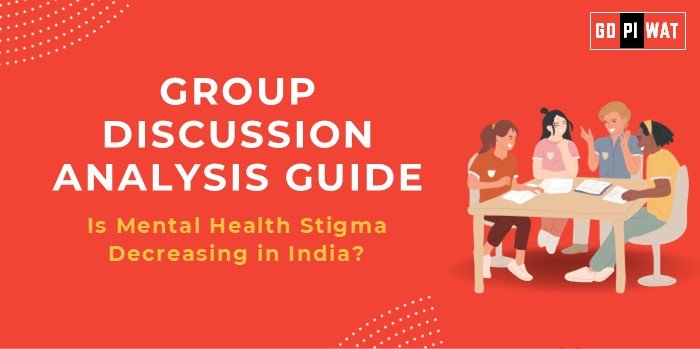📋 Group Discussion Analysis Guide: Is Mental Health Stigma Decreasing in India?
🌐 Introduction to the Topic
Opening Context: Mental health awareness is increasingly gaining prominence globally. In India, the conversation around mental health has witnessed significant evolution in recent years, driven by advocacy, education, and media representation.
Topic Background: Historically, mental health has been shrouded in stigma in India, fueled by misconceptions and societal taboos. However, shifts in policies, initiatives like the Mental Healthcare Act, 2017, and rising youth advocacy suggest progress in combating stigma.
📊 Quick Facts and Key Statistics
💼 Workplace Awareness: 55% of companies now provide mental health resources, a 20% increase since 2019.
💰 Budget Allocation: 1.5% of the healthcare budget was allocated to mental health in 2023—an improvement from 0.1% in 2018.
⚠️ Suicide Rates: Despite stigma reduction, India recorded the highest global suicide rate among youth in 2021 (National Crime Records Bureau).
📱 Telehealth Expansion: The pandemic accelerated telepsychiatry services, growing by 250% in 2022.
🤝 Stakeholders and Their Roles
- 🏛️ Government: Enacts legislation and funds mental health services (e.g., National Mental Health Programme).
- 📢 NGOs and Advocacy Groups: Raise awareness, combat stigma, and provide grassroots-level mental health support.
- 💼 Corporate Sector: Introduces workplace wellness initiatives.
- 🏫 Educational Institutions: Promote youth awareness through counseling and campaigns.
- 📰 Media and Influencers: Drive narratives that normalize conversations around mental health.
🏆 Achievements and Challenges
✨ Achievements:
- 📞 Tele-MANAS Program: Providing free 24/7 mental health support.
- 📣 Youth-led Movements: Promoting mental health awareness.
- 🩺 Primary Healthcare Integration: Mental health modules added to primary healthcare.
⚠️ Challenges:
- 🌍 Rural Stigma: Persistent stigma in rural areas where traditional beliefs dominate.
- 👩⚕️ Workforce Shortage: Only 0.75 psychiatrists per 100,000 people.
- 💸 Budget Constraints: Limited funding compared to international standards.
🌍 Global Comparisons:
- 🇯🇵 Japan: Integration of workplace mental health programs serves as a model.
- 🇦🇺 Australia: Community-based mental health services demonstrate scalable success.
📚 Case Studies:
- 📍 Maharashtra: Regional campaigns increased therapy access by 40%.
- 📍 Kerala: School mental health programs improved adolescent well-being.
🗣️ Structured Arguments for Discussion
Supporting Stance: “Mental health awareness campaigns and policy advancements show that India is progressing in reducing stigma.”
Opposing Stance: “Deep-seated cultural taboos and inadequate resources indicate that stigma reduction is far from complete.”
Balanced Perspective: “While mental health stigma is decreasing, progress is uneven across urban and rural India.”
💡 Effective Discussion Approaches
- 📊 Opening Approaches:
- Highlight statistics about rising mental health conversations.
- Start with a contrasting narrative of urban and rural progress.
- 🛠️ Counter-Argument Handling: Acknowledge rural stigma while emphasizing urban acceptance of therapy and counseling services.
📈 Strategic Analysis: SWOT
- 🏅 Strengths: Rising awareness, youth activism, telehealth expansion.
- ⚠️ Weaknesses: Workforce deficit, low rural engagement.
- 💡 Opportunities: Integration with education, digital innovations in telehealth.
- ⚡ Threats: Persistent societal resistance, lack of funding.
🎓 Connecting with B-School Applications
- 📚 Real-World Applications: Explore HR policies for mental well-being, CSR in mental health.
- 💬 Sample Interview Questions:
- “How can technology help reduce mental health stigma?”
- “What role should corporations play in employee mental health?”
- 🔑 Insights for B-School Students: Mental health as a CSR focus and research avenues in policy and awareness strategies.


